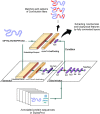PFP-WGAN: Protein function prediction by discovering Gene Ontology term correlations with generative adversarial networks
- PMID: 33630862
- PMCID: PMC7906332
- DOI: 10.1371/journal.pone.0244430
PFP-WGAN: Protein function prediction by discovering Gene Ontology term correlations with generative adversarial networks
Abstract
Understanding the functionality of proteins has emerged as a critical problem in recent years due to significant roles of these macro-molecules in biological mechanisms. However, in-laboratory techniques for protein function prediction are not as efficient as methods developed and processed for protein sequencing. While more than 70 million protein sequences are available today, only the functionality of around one percent of them are known. These facts have encouraged researchers to develop computational methods to infer protein functionalities from their sequences. Gene Ontology is the most well-known database for protein functions which has a hierarchical structure, where deeper terms are more determinative and specific. However, the lack of experimentally approved annotations for these specific terms limits the performance of computational methods applied on them. In this work, we propose a method to improve protein function prediction using their sequences by deeply extracting relationships between Gene Ontology terms. To this end, we construct a conditional generative adversarial network which helps to effectively discover and incorporate term correlations in the annotation process. In addition to the baseline algorithms, we compare our method with two recently proposed deep techniques that attempt to utilize Gene Ontology term correlations. Our results confirm the superiority of the proposed method compared to the previous works. Moreover, we demonstrate how our model can effectively help to assign more specific terms to sequences.
Conflict of interest statement
The authors have declared that no competing interests exist.
Figures






Similar articles
-
PFP/ESG: automated protein function prediction servers enhanced with Gene Ontology visualization tool.Bioinformatics. 2015 Jan 15;31(2):271-2. doi: 10.1093/bioinformatics/btu646. Epub 2014 Oct 1. Bioinformatics. 2015. PMID: 25273111 Free PMC article.
-
PFP: Automated prediction of gene ontology functional annotations with confidence scores using protein sequence data.Proteins. 2009 Feb 15;74(3):566-82. doi: 10.1002/prot.22172. Proteins. 2009. PMID: 18655063
-
GOLabeler: improving sequence-based large-scale protein function prediction by learning to rank.Bioinformatics. 2018 Jul 15;34(14):2465-2473. doi: 10.1093/bioinformatics/bty130. Bioinformatics. 2018. PMID: 29522145
-
Machine learning approach to gene essentiality prediction: a review.Brief Bioinform. 2021 Sep 2;22(5):bbab128. doi: 10.1093/bib/bbab128. Brief Bioinform. 2021. PMID: 33842944 Review.
-
Automatic Gene Function Prediction in the 2020's.Genes (Basel). 2020 Oct 27;11(11):1264. doi: 10.3390/genes11111264. Genes (Basel). 2020. PMID: 33120976 Free PMC article. Review.
Cited by
-
Generative models for protein sequence modeling: recent advances and future directions.Brief Bioinform. 2023 Sep 22;24(6):bbad358. doi: 10.1093/bib/bbad358. Brief Bioinform. 2023. PMID: 37864295 Free PMC article. Review.
-
Deep learning on graphs for multi-omics classification of COPD.PLoS One. 2023 Apr 21;18(4):e0284563. doi: 10.1371/journal.pone.0284563. eCollection 2023. PLoS One. 2023. PMID: 37083575 Free PMC article.
-
An Augmented High-Dimensional Graphical Lasso Method to Incorporate Prior Biological Knowledge for Global Network Learning.Front Genet. 2022 Jan 27;12:760299. doi: 10.3389/fgene.2021.760299. eCollection 2021. Front Genet. 2022. PMID: 35154240 Free PMC article.
-
Protein function prediction with gene ontology: from traditional to deep learning models.PeerJ. 2021 Aug 24;9:e12019. doi: 10.7717/peerj.12019. eCollection 2021. PeerJ. 2021. PMID: 34513334 Free PMC article.
References
Publication types
MeSH terms
Substances
LinkOut - more resources
Full Text Sources
Other Literature Sources

